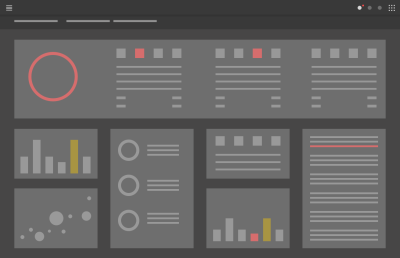Don’t Underestimate The Software Administration UX
“We sometimes underestimate the influence of little things.”
— Charles Chesnutt
It lives in the deepest and darkest corners of enterprise software… Mostly in the background… Never seen by the majority of end users… What is it?
It’s the administration and management layer of any software platform.
In fact, administration experience is often assumed or glossed over in software, because 99% users never engage with it directly. Yet this is one critical area that, when used effectively, can tie closely to a company’s business strategy, and affects the bottom line.
What Is Platform Administration?
Let’s align on the definition first. When people think about administration experience, most often it’s equated with either a modern dashboard panel with various system metrics or tedious utility pages with miscellaneous settings and configurations. However, the administration experience is far more comprehensive.
Administration experience is an end-to-end ecosystem that covers a wide range of administrative responsibilities — from active to passive. This includes installation/provisioning, configuration, user onboarding, scaling up/down, troubleshooting, security governance, and much more. It’s the full lifecycle of management and maintenance of the software platform and ensures the system works in sync with the company’s existing IT infrastructure.

Unfortunately, given that these functions mostly serve a very narrow set of personas (administrators), it’s not surprising to see that the user experience in the administration domain has lagged behind or been ignored in many software products on the market today, compared to end user product functions.
Why Should Customers Care?
From the definition above, we have already highlighted why administration experience is important. It’s understandable that we all want to just turn the faucet on and have the water running without worrying about the plumbing. However, when the plumbing doesn’t work, no one cares how nice the toilet looks.
There are many consequences a failing software administration can cause. Here is one example that’s not far away in this covid pandemic. The CDC ordered a $44 million vaccine administration system that was meant to manage the vaccine rollout. Instead, it has been plagued by problems and badly hurt the immunization progress.
Administration is the first step before any value of a software can be fulfilled. Too often, we see companies get stuck at the installation phase of a complex system for months, severely delaying the realization of Return on Investment (ROI).
With increasing concern for data security, access control in the software administration plays a vital role. It affects the efficacy of data isolation, and how access and permissions are precisely granted. Most importantly, with the increasing demands on system admins today, well-designed administrative capabilities can help them perform their day to day work more efficiently. How administration is handled can either be a booster or a bottleneck to the overall productivity of an organization.
Why Should Software Companies Care?
Besides the obvious reason that customers rely on a smooth administration experience to gain value for their software purchase, essential administration features also affect a software vendor’s bottom line. First, if the customers can’t start using the product within a timeframe due to deployment challenges, the initial purchase order and contract may not be fulfilled. Second, talk to any software support team and it may surprise you how many opened tickets from customers are related to administrative issues; such as installation, user management or setup and configuration.
Calculate the average time-to-resolve for these tickets, multiplied by the number of tickets and the hourly rate of the support staff, and you are likely to get an appallingly large number after your dollar sign. These kinds of calculations serve to hammer home how much a poorly implemented administration feature in the software may cost the business; not to mention the diminishing trust from the clients and declining Net Promoter Score (NPS) as an effect.
Conversely, strong administration and management capabilities perpetuate the success of a software platform business model, build loyalty among its users, and help the software company outperform its competition.

Let’s imagine a software platform that comes with a well-designed centralized administration. An admin can onboard users and give them access to different services efficiently without repeating the same process in siloed locations. This also allows for better governance without sacrificing collaboration.
With more users gaining access to the services quickly, more content is created and more services are deployed. When the platform’s value increases, it motivates more users and teams to join. As the network continues to grow, customers are more inclined to bring other existing tools into that same platform. With a well-guided integration experience in administration, the system can help customers achieve such goals with ease.
The more services and tools that the customers bring in, the stickier the software platform becomes to their organizations. In this example, administration experience leads to a self-reinforcing network effect that helps the business grow organically.
Why Does Administration Matter To Software As A Service (SaaS)?
With the number of SaaS products increasing rapidly in recent years, one might argue that administration is not so important in SaaS since the infrastructure and software maintenance are managed and abstracted from the users. It’s true that more companies are taking advantage of SaaS solutions. In fact, Gartner expects the global end-user spending on SaaS will exceed $170 Billion next year. However, even though the installation process is abstracted from SaaS applications, there are many other administrative areas that require a great amount of attention.
- Organizations still need visibility into SaaS usage in order to optimize their license entitlements and consumption.
How are services and apps being used? How many of these services are paid based on consumption? or contractual subscription based on tiered usage? Who are the users of these services? Finally, how much are these services costing your organization? As a key aspect of administration, licensing and usage management related features help companies with better cost analysis and control. - Identity and access management is always relevant regardless of software or SaaS.
A streamlined user management experience with out-of-box roles can greatly reduce onboarding time; allowing end users to get to the core value of the application more efficiently. - Security posture still needs to be established and enforced consistently.
While security policies might not be directly defined by administrators, they need to work with the company’s CISO to ensure the SaaS applications are in compliance with the security requirements. A SaaS application that comes with transparent information on cloud native security and centralized controls of identity, access and data governance will gain a competitive edge.
According to a recent Gartner report, many organizations, especially midsize enterprises, have migrated the majority of core applications to SaaS. With this trend, it’s also not a far reaching prospect to see organizations look at automating repetitive administration tasks to increase efficiency. SaaS or not, experiences that help admins reduce work redundancy and boost productivity will certainly be favored by the market.

As organizations continue to enlarge their SaaS footprint in their business and IT solutions, it is also worth evaluating the rising needs for SaaS management and visibility of the business’s entire software stack. With a good administration and management system in place, a company can track usage, spending and compliance with ease, and respond quickly when changes arise.
To continue our plumbing metaphor: when a tenant rents an apartment building, it’s expected that the water is running with regular pipe maintenance. No one wants to hear the building owner blame the plumbing company for any water problems.
Areas To Consider When Designing The Administration Experience
We’ve seen from many perspectives why the administration experience is critical to a company’s business strategy and clients’ success. Administration, by itself, also poses complex design challenges for anyone who’s passionate about user experience.
Here are a few things for designers and developers to consider when striving to bring a top-tier administration experience to life:
Design For Efficiency
Administration is a demanding, fast-paced, and high-pressure environment. Beyond regular maintenance and system updating, admins are typically the first-line responders for emergency situations that call for IT help. Because administrators are busy people with wildly varying days, our research reveals that they don’t want to spend the bulk of their day gazing at a software interface.
As one admin pointed out,
“Unless there’s a problem, I won’t poke around in the dashboard.”
Another confirmed,
“I want to set up alerts so I don’t have to proactively monitor metrics to make sure that I’m not going over something.”
As designers, our challenge is to create a product that does not encumber these administrators. Instead of keeping them locked into the interface with fleshy dials and graphs, the experience needs to be well-guided, streamlined, and intelligent; so maximum aid is provided to help administrations get in and out fast.
For example, in managing the system usage, design a system that will not only alert the admin when it’s exceeding the licensed amount, but also point out which service exactly is eating the usage, and give guidance on what to do next. If a higher tier license needs to be purchased, perhaps it can take the admin to the action page. Even better is if a system can give future predictions and recommendations for a purchase option based on the current metrics.

Design For Scalability
Administration requires design considerations on a large scale, especially for enterprise level solutions. Think about Identity and Access (IAM). It might be easy to design user management for one service.
But, what if there are dozens or hundreds of services that share the same user directory? What if multiple departments are sharing the same software platform deployment with separate data? What if collaborations among users from different accounts are needed?
The complexity of the user access problems can snowball even faster when balancing the experience with the technical feasibility. Suddenly, the plan for a solution that accommodates enterprise-scale management is no longer simple and straightforward. This requires designers and their technology partners to ask the right question from the starting point. We must understand not just the immediate needs, but also the long term vision in order to conceive a solution that can accommodate an increasing scale.
Leverage Emerging Technology
The manual process of many administrative capabilities gives designers a great opportunity to champion emerging technology, such as artificial intelligence (AI) and Robotic Processing Automation (RPA), in their design solutions to increase the productivity of administrative work.
Next time, when you design for an administrative task, such as configuring service backup and restore, after mapping out the general task flow, identify what are the repetitive steps in the set-up process, and whether they can be automated. Imagine how efficient it would be if an admin only needed to set up backup cadence and storage location for one single service and automate the same settings for all the other services.

Also, consider the predictive and suggestive nature of many machine-learning algorithms. Can one be integrated in the system to help admin troubleshoot?
To illustrate the idea, think about when a database is reported frozen due to the archive log being full. What if the system could not only point out the problem, but also give suggestions and automated fixes; such as adding one more archive log destination to resolve the issue. Further, if the same problem occurs many times, can the system surface such insights and give recommendations on how to fix the root cause? Could it suggest that the administrator schedule a cron job to delete logs before it reaches full capacity?
With these capabilities, an administrator’s approach towards troubleshooting may no longer need to be reactive, but could also proactively optimize the system before incidents even happen.
For those who believe in the power of design to bridge the gap between technology and the needs of the users, administration provides a perfect venue to make an impactful difference.
Don’t Underestimate
“When you believe in what you’re doing and use your imagination and initiative, you can make a difference.”
— Samuel Dash
Next time when someone makes a flippant decision on administration design, ask them to think again. The complex domains that software administrators tackle today create vast opportunities for us to build many delightful interactions that can not only exceed customer expectations, but also bring successful product outcomes.
Other Resources
- “Lessons In Design Great Enterprise Software”, Etan Lightstone
To learn about some general design considerations in enterprise software. - Digital Platform Ecosystems
To understand more about the software platform theory: Digital Platform ecosystems - “The Rise Of SaaS Management”, Andre Christ
To read more on the administration and management needs in SaaS.
This article is personal and does not necessarily represent IBM’s positions, strategies, or opinions.
Further Reading
- The Role Of Illustration Style In Visual Storytelling
- An Introduction To CSS Scroll-Driven Animations: Scroll And View Progress Timelines
- Transforming The Relationship Between Designers And Developers
- The Importance Of Graceful Degradation In Accessible Interface Design








